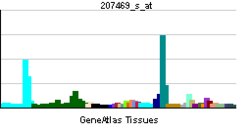PIR (gene)
| Pirin (iron-binding nuclear protein) | |||||||||||||
|---|---|---|---|---|---|---|---|---|---|---|---|---|---|
 PDB rendering based on 1j1l. | |||||||||||||
| |||||||||||||
| Identifiers | |||||||||||||
| Symbol | PIR | ||||||||||||
| External IDs | OMIM: 603329 MGI: 1916906 HomoloGene: 2717 GeneCards: PIR Gene | ||||||||||||
| EC number | 1.13.11.24 | ||||||||||||
| |||||||||||||
| RNA expression pattern | |||||||||||||
 | |||||||||||||
| More reference expression data | |||||||||||||
| Orthologs | |||||||||||||
| Species | Human | Mouse | |||||||||||
| Entrez | 8544 | 69656 | |||||||||||
| Ensembl | ENSG00000087842 | ENSMUSG00000031379 | |||||||||||
| UniProt | O00625 | Q9D711 | |||||||||||
| RefSeq (mRNA) | NM_001018109 | NM_027153 | |||||||||||
| RefSeq (protein) | NP_001018119 | NP_081429 | |||||||||||
| Location (UCSC) | Chr X: 15.4 – 15.51 Mb | Chr X: 164.27 – 164.37 Mb | |||||||||||
| PubMed search | |||||||||||||
Pirin is a protein that in humans is encoded by the PIR gene.[1][2]
This gene encodes a member of the cupin superfamily. The encoded protein is an Fe(II)-containing nuclear protein expressed in all tissues of the body and concentrated within dot-like subnuclear structures. Interactions with nuclear factor I/CCAAT box transcription factor as well as B cell lymphoma 3-encoded oncoprotein suggest the encoded protein may act as a transcriptional cofactor and be involved in the regulation of DNA transcription and replication. Alternatively spliced transcript variants have been described.[2]
Interactions
PIR (gene) has been shown to interact with BCL3.[3]
References
- ↑ Wendler WM, Kremmer E, Forster R, Winnacker EL (May 1997). "Identification of pirin, a novel highly conserved nuclear protein". J Biol Chem 272 (13): 8482–9. doi:10.1074/jbc.272.13.8482. PMID 9079676.
- ↑ 2.0 2.1 "Entrez Gene: PIR pirin (iron-binding nuclear protein)".
- ↑ Dechend, R; Hirano F; Lehmann K; Heissmeyer V; Ansieau S; Wulczyn F G; Scheidereit C; Leutz A (Jun 1999). "The Bcl-3 oncoprotein acts as a bridging factor between NF-kappaB/Rel and nuclear co-regulators". Oncogene (ENGLAND) 18 (22): 3316–23. doi:10.1038/sj.onc.1202717. ISSN 0950-9232. PMID 10362352.
Further reading
- Rual JF, Venkatesan K, Hao T et al. (2005). "Towards a proteome-scale map of the human protein-protein interaction network.". Nature 437 (7062): 1173–8. doi:10.1038/nature04209. PMID 16189514.
- Adams M, Jia Z (2005). "Structural and biochemical analysis reveal pirins to possess quercetinase activity.". J. Biol. Chem. 280 (31): 28675–82. doi:10.1074/jbc.M501034200. PMID 15951572.
- Gerhard DS, Wagner L, Feingold EA et al. (2004). "The status, quality, and expansion of the NIH full-length cDNA project: the Mammalian Gene Collection (MGC).". Genome Res. 14 (10B): 2121–7. doi:10.1101/gr.2596504. PMC 528928. PMID 15489334.
- Colland F, Jacq X, Trouplin V et al. (2004). "Functional proteomics mapping of a human signaling pathway.". Genome Res. 14 (7): 1324–32. doi:10.1101/gr.2334104. PMC 442148. PMID 15231748.
- Pang H, Bartlam M, Zeng Q et al. (2004). "Crystal structure of human pirin: an iron-binding nuclear protein and transcription cofactor.". J. Biol. Chem. 279 (2): 1491–8. doi:10.1074/jbc.M310022200. PMID 14573596.
- Zeng Q, Li X, Bartlam M et al. (2004). "Purification, crystallization and preliminary X-ray analysis of human pirin.". Acta Crystallogr. D Biol. Crystallogr. 59 (Pt 8): 1496–8. doi:10.1107/S0907444903012289. PMID 12876364.
- Strausberg RL, Feingold EA, Grouse LH et al. (2003). "Generation and initial analysis of more than 15,000 full-length human and mouse cDNA sequences.". Proc. Natl. Acad. Sci. U.S.A. 99 (26): 16899–903. doi:10.1073/pnas.242603899. PMC 139241. PMID 12477932.
- Dechend R, Hirano F, Lehmann K et al. (1999). "The Bcl-3 oncoprotein acts as a bridging factor between NF-kappaB/Rel and nuclear co-regulators.". Oncogene 18 (22): 3316–23. doi:10.1038/sj.onc.1202717. PMID 10362352.
| |||||||||
